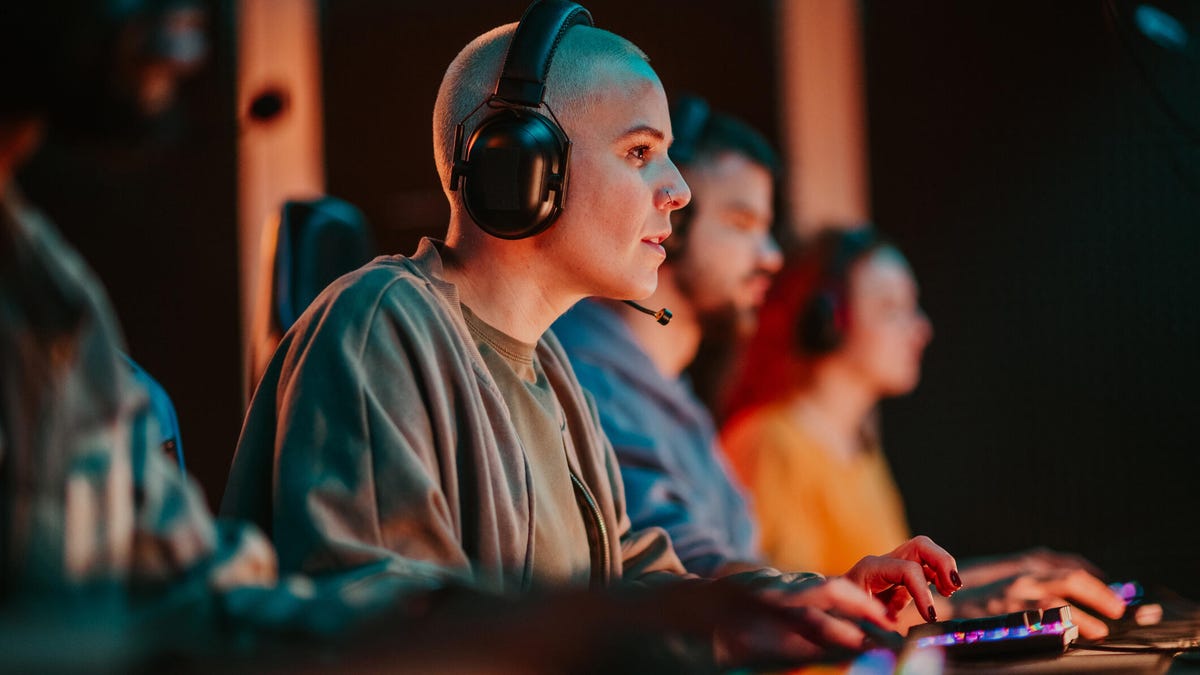Technologies
How to Play Soulframe Preludes. The Limited Alpha Period Starts Now
Developer Digital Extremes is opening the doors to its fantasy adventure, at least for this weekend. Here’s how to join.

Whether you’re a fan of Warframe’s brand of sci-fi RPG ninja looting or you’re locked in on Elden Ring Nightreign’s hard-core dark fantasy raids, developer Digital Extremes’ next game might be right up your alley.
Soulframe is an upcoming dark fantasy MMO experience where players, controlling powerful characters known as Envoys, burn the evil out of the land of Midrath. Whereas Warframe is a sci-fi adventure, Soulframe explores human connections with nature through a world of living fables.
The game’s combat centers on third-person hack-and-slash action, as well as magic and ranged weaponry. The classic Digital Extremes attention to detail was put into the arsenal of weapons, which will grow and expand alongside the game.
During the weekend of July 19, as TennoCon 2025 roars to life, all prospective Soulframe players will be allowed into a brief test of the game as the alpha opens up. Here’s how to try it out.
Read more: Warframe Isleweaver’s Spider-Man-Like Frame Is a Masterpiece of Design
What is Soulframe Preludes?
Soulframe is the biggest game developed by Digital Extremes since the release of Warframe in 2013. Despite the similar naming conventions, Soulframe isn’t a prequel to Warframe. The two games take place in entirely separate worlds and spin out unrelated narratives. This is a brand-new game with different gameplay mechanics that’s perfect for players looking to jump into something different.
Soulframe Preludes is the closed alpha version of the game, meaning a lot could change between now and the actual release. The latest update, Soulframe Preludes 10, went live May 27.
The current iteration of the game lets players battle corrupted foes like the Will-o-wings and Mendicant King, wield fearsome weapons and sidearms and even ally with factions to befriend their very own (fearsome) wolf pup.
Soulframe Preludes is a way for development to continue while gathering community suggestions from previewing players, and getting a key to the closed alpha qualifies you to join a special Discord server (and will unlock for you the Alca’s Eye item in-game upon the full release, as appreciation for your feedback).
How to get into the Soulframe Preludes alpha during TennoCon 2025
Soulframe Preludes is currently available only to PC gamers because this is a limited alpha launch intended for community-centric testing and development.
Anyone who creates a Soulframe account will be able to access Soulframe Preludes 10 for the duration of TennoCon 2025. Here’s a step-by-step guide to start your Soulframe journey:
-
Go to Soulframe’s online home page.
-
Click the «join us» button.
-
Fill out an email address, password and envoy name (this will become your Soulframe in-game name, so choose wisely).
-
Accept the privacy policy and participation agreement.
-
Click «join us» and check your email for a verification link.
-
Optionally, you can navigate to your account’s personal information and link a Twitch account to earn Soulframe Twitch drops for the game’s full release.
-
Download the Soulframe Preludes build from the website’s home page.
Can I play Soulframe Preludes after TennoCon?
You’ll be able to play Soulframe Preludes after the TennoCon open alpha test is closed, but you’ll once more need to sit tight for an access key to do so. You need a Soulframe account spun up to be eligible for Soulframe Preludes access.
The good news is that following the same steps to enter Soulframe Preludes during TennoCon 2025 puts you in the pool to be sent a key to access the game after the alpha closes again. It’s likely there will be additional open play tests in the future, but Digital Extremes hasn’t indicated when those might be — so if you want to play soon, keep an eye on your email.
Once you’ve verified your email address, there’s nothing else you can do but wait for a Soulframe Preludes key. These are released in weekly waves and include keys for friends as well, so if you’re lucky enough to have co-op buddies, they might be able to usher you into the alpha more quickly.
Technologies
If You Were ‘Tricked’ Into an Amazon Prime Subscription, You Should Have Been Paid by Today
Amazon is paying $1.5 billion to people who mistakenly subscribed to Prime, and the first round of payments are due today.

Amazon Prime provides a lot of valuable benefits to its members, but the company’s registration practices for its premium subscription from 2019 to 2025 led to many customers accidentally subscribing to a service they didn’t want.
Amazon is now paying the price for that deception — the US Federal Trade Commission levied a massive $2.5 billion settlement on the company for its subscription tactics.
The majority of the settlement — $1.5 billion — has been earmarked to refund eligible subscribers, with the rest serving as a civil penalty. Amazon is also now legally required to provide a clear, obvious option to decline Prime, making it as easy to leave the service as it is to join.
Amazon isn’t admitting to shady behavior. «Amazon and our executives have always followed the law, and this settlement allows us to move forward and focus on innovating for customers,» Mark Blafkin, Amazon senior manager, said in a statement. «We work incredibly hard to make it clear and simple for customers to both sign up or cancel their Prime membership, and to offer substantial value for our many millions of loyal Prime members around the world.»
The online retail giant started sending out payments to eligible people in November and was supposed to conclude its initial automatic payments today, Dec. 24. Read on to learn more about Amazon’s settlement and what to do if you think you’re eligible for compensation but didn’t receive a payment.
Why did the FTC fine Amazon?
The FTC filed suit against Amazon, accusing the company of using «dark patterns» to nudge people into Prime subscriptions and then making it too hard to cancel. The FTC maintained Amazon was in violation of Section 5 of the FTC Act and the Restore Online Shoppers’ Confidence Act.
«Specifically, Amazon used manipulative, coercive or deceptive user-interface designs known as ‘dark patterns’ to trick consumers into enrolling in automatically renewing Prime subscriptions,» the FTC complaint stated.
Who’s eligible for Amazon’s payout?
Amazon’s legal settlement is limited to customers who enrolled in Amazon Prime between June 23, 2019, and June 23, 2025. It’s also restricted to customers who subscribed to Prime using a «challenged enrollment flow» or who enrolled in Prime through any method but were unsuccessful in canceling their memberships.
The FTC called out specific enrollment pages, including Prime Video enrollment, the Universal Prime Decision page, the Shipping Option Select page and the Single Page Checkout. To qualify for a payout, claimants must also not have used more than 10 Amazon Prime benefits in any 12-month period.
Customers who signed up via those challenged processes and did not use more than three Prime benefits within one year will be paid automatically by Amazon within 90 days. Other eligible Amazon customers will need to file a claim, and Amazon is required to send notices to those people within 30 days of making its automatic payments.
If you are eligible for the automatic payment, you should have received an email from Amazon by today explaining how to claim the money. You can be paid via PayPal or Venmo. If you prefer a paper check, don’t accept the digital payment. The FTC says Amazon will mail you a check that you must cash within 60 days.
How big will the Amazon payments be?
Payouts to eligible Amazon claimants will be limited to a maximum of $51. That amount could be reduced depending on the number of Amazon Prime benefits you used while subscribed to the service. Those benefits include free two-day shipping, watching shows or movies on Prime Video or Whole Foods grocery discounts.
Customers who qualify for the payments should have received them from Nov. 12 to Dec. 24, 2025.If you are eligible for compensation from Amazon but didn’t receive a payout, you’ll need to file a claim after Amazon starts the claim process. The FTC says it will update its Amazon settlement site once that process has begun.
Customers who did not use a challenged sign-up process but instead were unable to cancel their Prime memberships will also need to file claims for payment.
Technologies
Today’s NYT Connections: Sports Edition Hints and Answers for Dec. 25, #458
Here are hints and the answers for the NYT Connections: Sports Edition puzzle for Dec. 25, No. 458.

Looking for the most recent regular Connections answers? Click here for today’s Connections hints, as well as our daily answers and hints for The New York Times Mini Crossword, Wordle and Strands puzzles.
Today’s Connections: Sports Edition has a real mix of categories, including one that’s all about a certain famous athlete. If you’re struggling with today’s puzzle but still want to solve it, read on for hints and the answers.
Connections: Sports Edition is published by The Athletic, the subscription-based sports journalism site owned by The Times. It doesn’t appear in the NYT Games app, but it does in The Athletic’s app. Or you can play it for free online.
Read more: NYT Connections: Sports Edition Puzzle Comes Out of Beta
Hints for today’s Connections: Sports Edition groups
Here are four hints for the groupings in today’s Connections: Sports Edition puzzle, ranked from the easiest yellow group to the tough (and sometimes bizarre) purple group.
Yellow group hint: Swing away!
Green group hint: What’s that on your bat?
Blue group hint: Catch the football.
Purple group hint: Lake Placid or Lillehammer.
Answers for today’s Connections: Sports Edition groups
Yellow group: Baseball bat materials.
Green group: Associated with George Brett.
Blue group: NFL rookie WRs.
Purple group: Olympic ____.
Read more: Wordle Cheat Sheet: Here Are the Most Popular Letters Used in English Words
What are today’s Connections: Sports Edition answers?
The yellow words in today’s Connections
The theme is baseball bat materials. The four answers are aluminum, ash, birch and maple.
The green words in today’s Connections
The theme is associated with George Brett. The four answers are 5, pine tar, Royals and third base.
The blue words in today’s Connections
The theme is NFL rookie WRs. The four answers are Burden, Egbuka, Golden and McMillan.
The purple words in today’s Connections
The theme is Olympic ____. The four answers are Games, rings, torch and village.
Don’t miss any of our unbiased tech content and lab-based reviews. Add CNET as a preferred Google source.
Technologies
Christmas Eve Gaming Crushed as Steam Goes Offline
Services related to the popular game hub seem to slowly be returning as of Wednesday afternoon.

Your Christmas Eve gaming session might not go as planned. Online gaming hub Steam went down on Wednesday. As of about 1:30 pm PT, the Steam store page was once again accessible, so services seemed to be coming back online.
The Steam outage appeared to begin mid-afternoon ET, according to Downdetector, which monitors site outages. (Disclosure: Downdetector is owned by the same parent company as CNET, Ziff Davis.)
A representative for Steam did not immediately respond to a request for comment.
As of Wednesday noon PT, Steam’s official X and Bluesky accounts hadn’t posted anything about the outage.
Gamers certainly noticed. «Steam down, Steam down!!!» wrote one Bluesky user.
Others commented on the bad timing just as gamers were enjoying time off or receiving gaming gifts. «‘You got a gift on Steam!’ oh cool ‘Steam is down’ oh cool,» wrote another Bluesky user.
-

 Technologies3 года ago
Technologies3 года agoTech Companies Need to Be Held Accountable for Security, Experts Say
-

 Technologies3 года ago
Technologies3 года agoBest Handheld Game Console in 2023
-

 Technologies3 года ago
Technologies3 года agoTighten Up Your VR Game With the Best Head Straps for Quest 2
-

 Technologies4 года ago
Technologies4 года agoBlack Friday 2021: The best deals on TVs, headphones, kitchenware, and more
-

 Technologies4 года ago
Technologies4 года agoVerum, Wickr and Threema: next generation secured messengers
-

 Technologies4 года ago
Technologies4 года agoGoogle to require vaccinations as Silicon Valley rethinks return-to-office policies
-

 Technologies4 года ago
Technologies4 года agoOlivia Harlan Dekker for Verum Messenger
-

 Technologies4 года ago
Technologies4 года agoiPhone 13 event: How to watch Apple’s big announcement tomorrow
